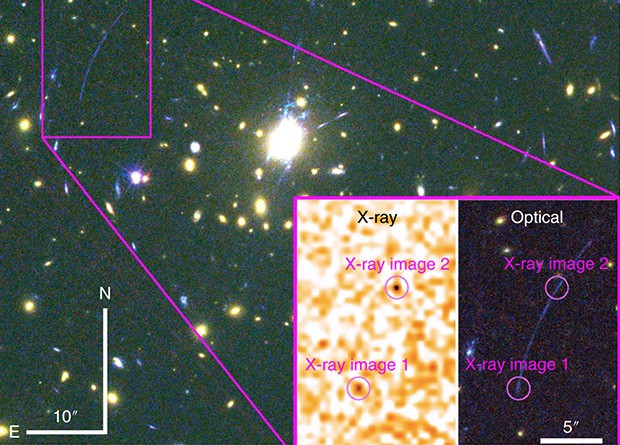A new study from renowned Astronomers managed to find an X-ray-bright galaxy from the young Universe, whose light was amplified by the gravity of a cluster of galaxies located closer to Earth. The studied object is an analogue of the very first galaxies in the Universe, the light of which re-ionized matter 0.5–1 billion years after the Big Bang.
According to the modern theory of gravity – Albert Einstein’s General Theory of Relativity – mass and energy distort space-time, which affects the course of any processes, including the movement of light. As a result, a situation is possible when the gravity of a massive body acts as a lens, amplifying the light of a source located behind. Astronomers use the effect of gravitational lensing to study objects of the early Universe, whose light due to the distance and expansion of space is too weak for direct registration. In particular, such an increase in the signal helps to study the extremely distant galaxies that existed on the order of one billion years ago.
Similar studies were carried out in many ranges of the electromagnetic spectrum, including ultraviolet, optical, infrared and millimeter. Nevertheless, until now, gravitational lensing could not be used for observations in the x-ray range. The main problem is that clusters of galaxies, which usually act as lenses, are immersed in long halo of hot gas, which itself actively shines in the x-ray range. It was believed that the lensed sources would not be bright enough to highlight clusters against the background of their own radiation.
Matthew Bayliss of the Massachusetts Institute of Technology and his colleagues described the first x-ray observations of a distant galaxy using gravitational lensing. The redshift of the cluster of Phoenix galaxies that acted as the lens was 0.6, and the background galaxy was 1.52. The light of a background galaxy was emitted more than 9 billion years ago, when the universe was about 4.2 billion years old.
The galaxy was accidentally found in an optical review, where its distorted image looks like a long and thin bluish streak. Subsequent long-term observations with the Chandra X-ray space telescope made it possible to detect its high-energy radiation. According to scientists, this galaxy is much smaller than the Milky Way, but there is active star formation and an extremely high density of exceptionally large and hot stars is already observed.
The authors were convinced that they were seeing a galaxy with a starburst, and not with an active nucleus, since the ratio of the brightness of the spectral lines was at an appropriate level. Astronomers estimate the gravitational increase in brightness by 65 ± 20 times. The undistorted image reconstructed using the mathematical model showed that the object is a small irregular galaxy with two centers of star formation no larger than one kiloparsec each.
Scientists note that although the brightness of this object was significantly increased by the lens, the galaxy itself was initially very dim in the x-ray range. This allows us to hope that a systematic search for lensed high-energy images will allow us to find many similar examples. The authors estimate that using the next generation of X-ray telescopes, one can hope to study the details of individual regions of star formation, as well as to observe extremely distant galaxies up to a redshift of the order of 10.
